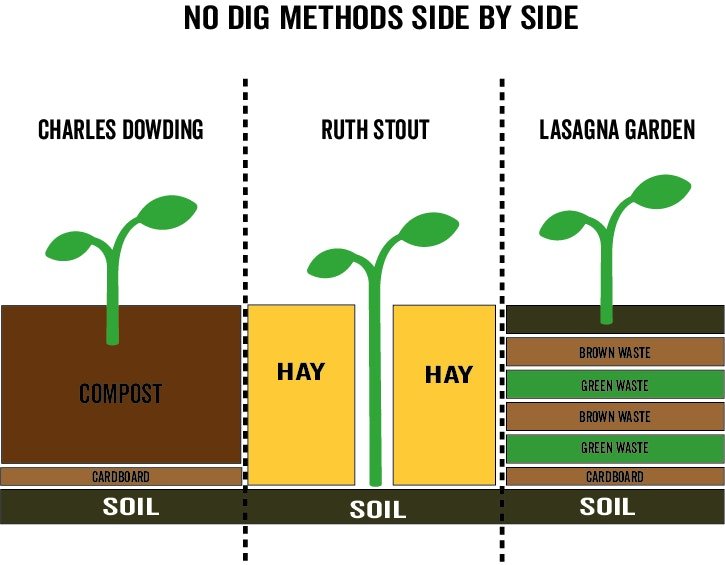Choosing Your No-Dig Gardening Adventure
Though a bit later than we had hoped, building up our 2022 veg garden beds has begun. This weekend, we emptied the hay barn of a season of spent hay, straw and manure and piled it on top of one of our 30m long raised beds.
Since we began gardening, we have always used a no-dig method of gardening, focusing on feeding the soil and not the plants. It works well for us, there is less weeding needed and once the bulk of the work is done in autumn and winter, we can just focus on the veg.
One of the things that I find semi-annoying in the world of gardening is how at times it can feel almost as if there are factions. Different gurus have different methods, each purporting to be the single best method…when in fact, the basic principles of no-dig gardening remain the same:
Compostable material is layered on top of the soil and planting goes into or through these mulches.
Mulches are piled high enough to exclude light, stopping weeds and grass from coming through
Throughout the growing season, the mulches feed the soil and continue to decompose
No Dig Methods:
I find that folk get evangelical about "their" method of no-dig gardening. All of them rely on heavy mulching to feed the soil and stop weeds.
We use the 3 main methods, depending on how, when and where the beds will be used for the year.
The Charles Dowding Method uses compost as its main mulch and growing medium. On our scale and with no machinery, this works out as an expensive option - either in time or money as for us, the amount of compost we need to create either needs more body power than we have for turning or a bigger budget than we have for buying in.
Ruth Stout uses spent hay as a mulch. This can be a good option if you have a local farmer who can give you last season's hay or straw for use in your bed. Some folk have problems with this method attracting slugs, but we haven't had problems.
Lasagna Gardening uses a mix of green (grass, vegetable scraps, manure) and brown (straw, wood chips, cardboard) to create essentially a compost bed on on your vegetable garden. This is probably the closest to the model we use throughout the garden as we us animal bedding as our main mulch.
No matter which route you follow, the benefits of these methods is that there is less work than a traditional double dug bed where weeding and adding soil amendments need to happen on regular intervals. Soil health and structure is maintained and enhanced and there is a wealth of evidence that shows that this type of gardening will reduce pests as healthy plants are less likely to attract pests in the first place.
The drawbacks are that there is still a fair amount of work to get started and you need a good amount of mulch to make a bed, which may have a cost.
Establishing a Basic Bed:
Your first step in establishing a no-dig bed is killing the grass or plants that may be growing there (or seeds may be dormant under the ground). Generally, there are a few ways this can happen.
You can pile enough mulch (6-9inches) to kill everything underneath. This can work, but it can be slightly tricky to get the consistency of depth to make sure nothing grows through.
You can lay a tarp on an area for a year or so to kill the grass on an area. Black landscape fabric is useful here for this. We do a modified version of this with our willow and squash beds. It's also a great way to establish a new bed for the following year. For the squashes, we spread a layer of manure on the grass, place the landscape fabric on top of it, make a hole in the fabric (usually with a blowtorch) and plant the squash seedlings through.
The most common method is to lay a layer of cardboard on the ground as a base layer. This attracts worms and also blocks out the light to kill the grass. Mulch is then piled on top of this.
Choosing Your Mulch
You will find as you begin to explore more around no-dig that every guru has their mulch of choice. Charles Dowding likes compost. Ruth Stout believes in the power of hay. Lasagne Gardeners swear by their layers of veg scraps. And Hugelkulturers build their foundations on sticks.
I don't think that there is one size fits all here. What you choose is going to depend on a number of factors, primarily, what can you access. We use a lot of waste hay and straw and a lot of manure mix from the barn. Thats what we have. Compost may work better, but we don't have the means to create it in the volume we need or buy it in the volumes we need.
Mulches:
Compost: decomposed organic matter in essence. You can make your own (more on that later in the course), you can buy it from garden centres or in bulk or many local authorities produce it for sale or uplift. The benefits are you can plant straight into it without much consideration The drawback is that you need a lot to fill a bed.
Straw and Hay: Ruth Stout loves hay as a mulch and we use it a lot. You can usually get waste hay from farmers as it can go off and be unsuitable for animal feed. You can even plant in straw bales, a method we have used and loved. The drawback is that it can germinate seed and harbour slugs - remedied by more mulching and slug treatments like coffee or beer traps.
Manure: by far and away, manure is our most used mulch for our no dig beds. Generally speaking, manure needs six months to a year to rot after being cleared out of a barn to plant into directly. That said, if it is hot composted, it can be ready to go in much less than that. Our rule is that when it stops smelling like poo, it is probably good to go. There are a few reasons to ensure your manure is composted before application:
Manure contains bacteria that can be harmful. The advice generally is that fresh manure should be applied at least 120 days from the harvest of the plants you are planting in it. Generally speaking in the UK, March would be the last time of year I would be applying fresh (straight out of the barn) manure on plants.
Fresh manure contains ammonia and nitrogen in high quantities and it can burn the roots of the plants.
Less- composted manure can be used, as long as it is balanced out with lots of brown waste like paper, cardboard or straw and kept away from plant roots by a thick layer of compost. We will also save "hotter" beds with fresh manure for things like squashes.
We choose our mulch for a specific based on a number of factors.
Cost - we build the bulk of our beds on what we can get freely and/or with the least amount of effort. This means using free hay and straw from local farmers that has spoiled and manure from the chicken coops and barns
What we are planting - things like squash, courgettes and melons love a really "hot" bed - they thrive in fresher manures, so if we are short on more rotted compost, we will use those for our squash beds. Root veg come in a lot of contact with the soil, so we use compost more on those beds


